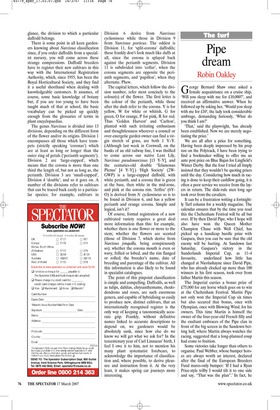Hosts of golden daffodils
Ursula Buchan
‘Golden Harvest’ 1 Y-Y, ‘High Society’ 2 W-GWP, ‘Jetfire’ 6 Y-O; these names strangely preoccupy me at this season of the year. If you think that my trolley and I have gone our separate ways, you cannot be au fait with the classification of Narcissus. If that is the case, I cannot say I exactly blame you, since life is short. However, there is, I assure you, a potent fascination in being able to nail, at a glance, the division to which a particular daffodil belongs.
There is some point in all keen gardeners knowing about Narcissus classification since, if you order daffodils from a specialist nursery, you will come across these strange compressions. Daffodil breeders have to register their new cultivars in this way with the International Registration Authority, which, since 1955, has been the Royal Horticultural Society, and they find it a useful shorthand when dealing with knowledgeable customers. It assumes, of course, some basic knowledge of botany but, if you are too young to have been taught much of that at school, the basic vocabulary can be picked up quickly enough from the glossaries of terms in plant encyclopaedias.
The genus Narcissus is divided into 13 divisions, depending on the different form of the flower and/or its origins. Division 1 encompasses all those which have trumpets (strictly speaking ‘coronas’) which are at least as long or longer than the outer ring of petals (‘perianth segments’). Division 2 are ‘large-cupped’, which means that the corona is more than one third the length of, but not as long as, the perianth. Division 3 are ‘small-cupped’, Division 4 ‘double’, and so it goes on. A number of the divisions refer to cultivars that can be traced back easily to a particular species; for example, cultivars in Division 6 derive from Narcissus cyclamineus while those in Division 9 from Narcissus poeticus. The oddest is Division 11, for ‘split-corona’ daffodils; these frankly don’t look much like daffs at all, since the corona is splayed back against the perianth segments. Division 11 is subdivided into ‘collar’, when the corona segments are opposite the perianth segments, and ‘papillon’, when they alternate. Phew.
The capital letters, which follow the division number, refer most concisely to the colour(s) of the flower. The first letter is the colour of the perianth, while those after the dash refer to the corona. Y is for yellow, W for white or whitish, G for green, O for orange, P for pink, R for red. Thus ‘Golden Harvest’ and ‘Carlton’, planted with such irritating enthusiasm and thoughtlessness wherever a council or over-energetic garden owner can find a virgin stretch of grass, are both 1 Y–Y. (Although last week in Cornwall, on the banks of an old railway line, I was thrilled to come across our native Lent Lily, Narcissus pseudonarcissus [13 Y-Y], and the centuries-old double ‘Telamonus Plenus’ [4 Y-Y].) ‘High Society’ (2WGWP) is a large-cupped daffodil, with white perianth, and a corona that is green at the base, then white in the mid-zone, and pink at the corona rim. ‘Jetfire’ (6YO) is derived from N. cyclamineus so is to be found in Division 6, and has a yellow perianth and orange corona. Simple and logical, isn’t it?
Of course, formal registration of a new cultivated variety requires a great deal more information than this: for example, whether there is one flower or more to the stem; whether the flowers are scented (those of Division 7, which derive from Narcissus jonquilla, being conspicuously so); whether the corona mouth is even or wavy, frilled or lobed, and the rim flanged or rolled; the breeder’s name, date of breeding and parentage of the cultivar. All this information is also likely to be found in specialist catalogues.
The point of this pinpoint classification is simple and compelling. Daffodils, as well as tulips, dahlias, chrysanthemums, rhododendrons and roses, are such enormous genera, and capable of hybridising so easily to produce new, distinct cultivars, that an internationally recognised register is the only way of keeping a taxonomically accurate grip. Frankly, without definitive names linked to accurate descriptions to depend on, we gardeners would be absolutely sunk, since how else do we know we will get what we ask for? In the tercentenary year of Carl Linnaeus’ birth, I feel I owe it to him, not to mention his many plant systematist forebears, to acknowledge the importance of classification and, where possible, to derive pleasure and instruction from it. At the very least, it makes spring car journeys more interesting.



































































































 Previous page
Previous page